Report: Decision Making and Problem Solving in Business
VerifiedAdded on 2023/01/06
|13
|3292
|54
Report
AI Summary
This report delves into the critical aspects of decision-making and problem-solving within a business framework. It begins by examining the hierarchical structure of information flow in organizations and how this impacts decision-making at various levels. The report then outlines a step-by-step approach to conducting business research to aid in effective decision-making, focusing on problem identification, research design, data collection, and analysis. Furthermore, it explores the different types of asymmetrical causal relationships, providing insights into how variables influence each other. The report also covers various interview formats used in qualitative data gathering, including structured, semi-structured, and unstructured interviews. Finally, it evaluates the measurement tools of validity, reliability, and practicality, as well as exploring content, construct, and criterion, providing a well-rounded understanding of the subject matter.
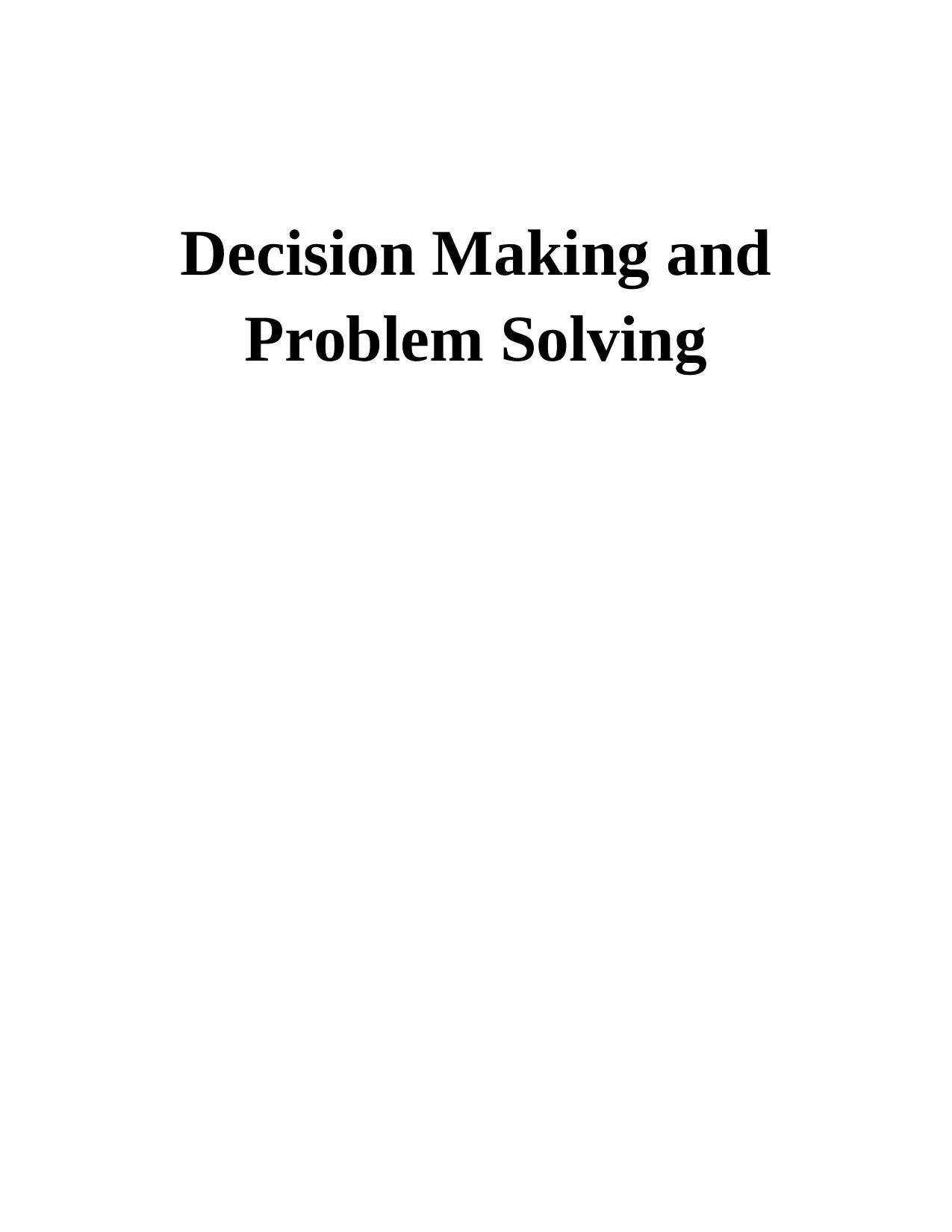
Decision Making and
Problem Solving
Problem Solving
Paraphrase This Document
Need a fresh take? Get an instant paraphrase of this document with our AI Paraphraser

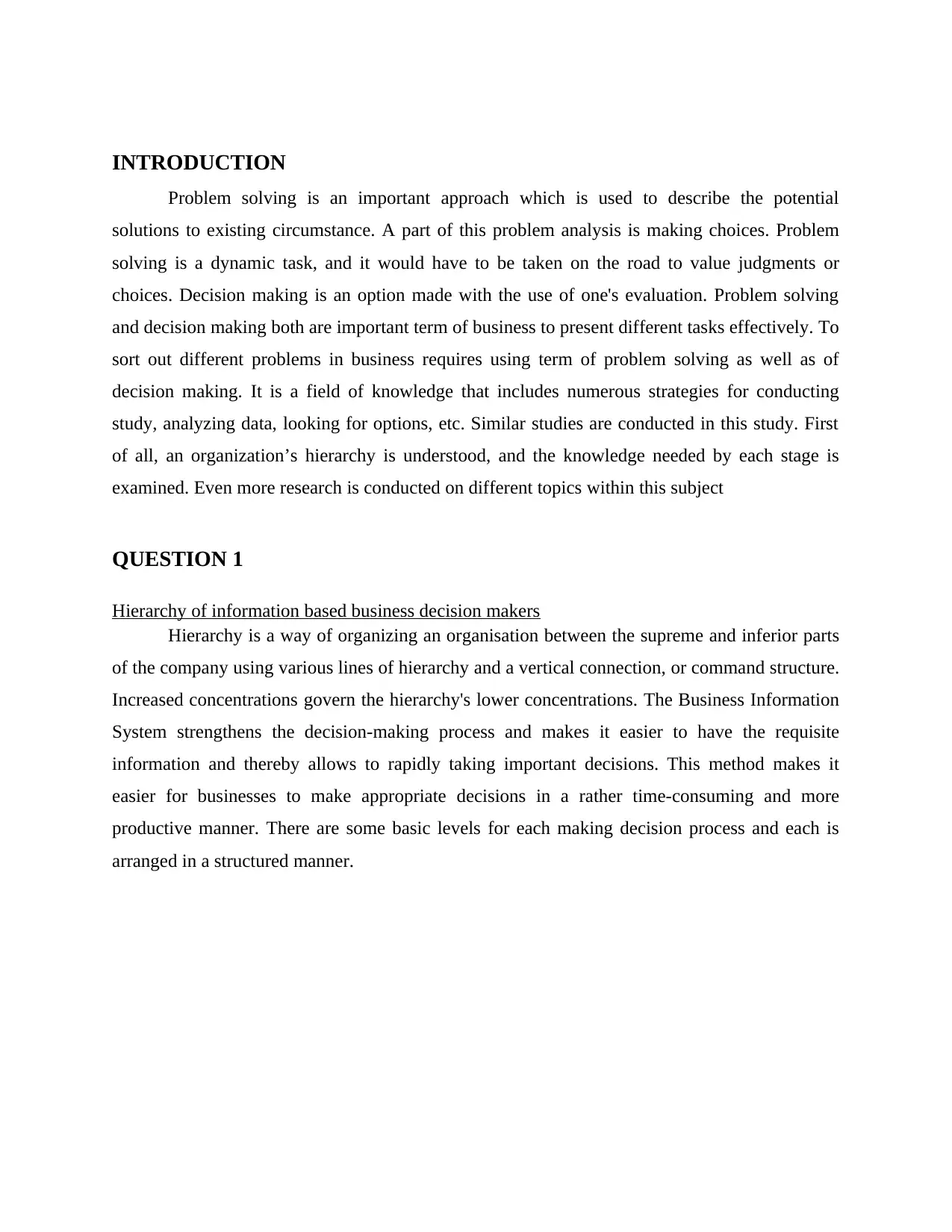
INTRODUCTION
Problem solving is an important approach which is used to describe the potential
solutions to existing circumstance. A part of this problem analysis is making choices. Problem
solving is a dynamic task, and it would have to be taken on the road to value judgments or
choices. Decision making is an option made with the use of one's evaluation. Problem solving
and decision making both are important term of business to present different tasks effectively. To
sort out different problems in business requires using term of problem solving as well as of
decision making. It is a field of knowledge that includes numerous strategies for conducting
study, analyzing data, looking for options, etc. Similar studies are conducted in this study. First
of all, an organization’s hierarchy is understood, and the knowledge needed by each stage is
examined. Even more research is conducted on different topics within this subject
QUESTION 1
Hierarchy of information based business decision makers
Hierarchy is a way of organizing an organisation between the supreme and inferior parts
of the company using various lines of hierarchy and a vertical connection, or command structure.
Increased concentrations govern the hierarchy's lower concentrations. The Business Information
System strengthens the decision-making process and makes it easier to have the requisite
information and thereby allows to rapidly taking important decisions. This method makes it
easier for businesses to make appropriate decisions in a rather time-consuming and more
productive manner. There are some basic levels for each making decision process and each is
arranged in a structured manner.
Problem solving is an important approach which is used to describe the potential
solutions to existing circumstance. A part of this problem analysis is making choices. Problem
solving is a dynamic task, and it would have to be taken on the road to value judgments or
choices. Decision making is an option made with the use of one's evaluation. Problem solving
and decision making both are important term of business to present different tasks effectively. To
sort out different problems in business requires using term of problem solving as well as of
decision making. It is a field of knowledge that includes numerous strategies for conducting
study, analyzing data, looking for options, etc. Similar studies are conducted in this study. First
of all, an organization’s hierarchy is understood, and the knowledge needed by each stage is
examined. Even more research is conducted on different topics within this subject
QUESTION 1
Hierarchy of information based business decision makers
Hierarchy is a way of organizing an organisation between the supreme and inferior parts
of the company using various lines of hierarchy and a vertical connection, or command structure.
Increased concentrations govern the hierarchy's lower concentrations. The Business Information
System strengthens the decision-making process and makes it easier to have the requisite
information and thereby allows to rapidly taking important decisions. This method makes it
easier for businesses to make appropriate decisions in a rather time-consuming and more
productive manner. There are some basic levels for each making decision process and each is
arranged in a structured manner.
⊘ This is a preview!⊘
Do you want full access?
Subscribe today to unlock all pages.

Trusted by 1+ million students worldwide
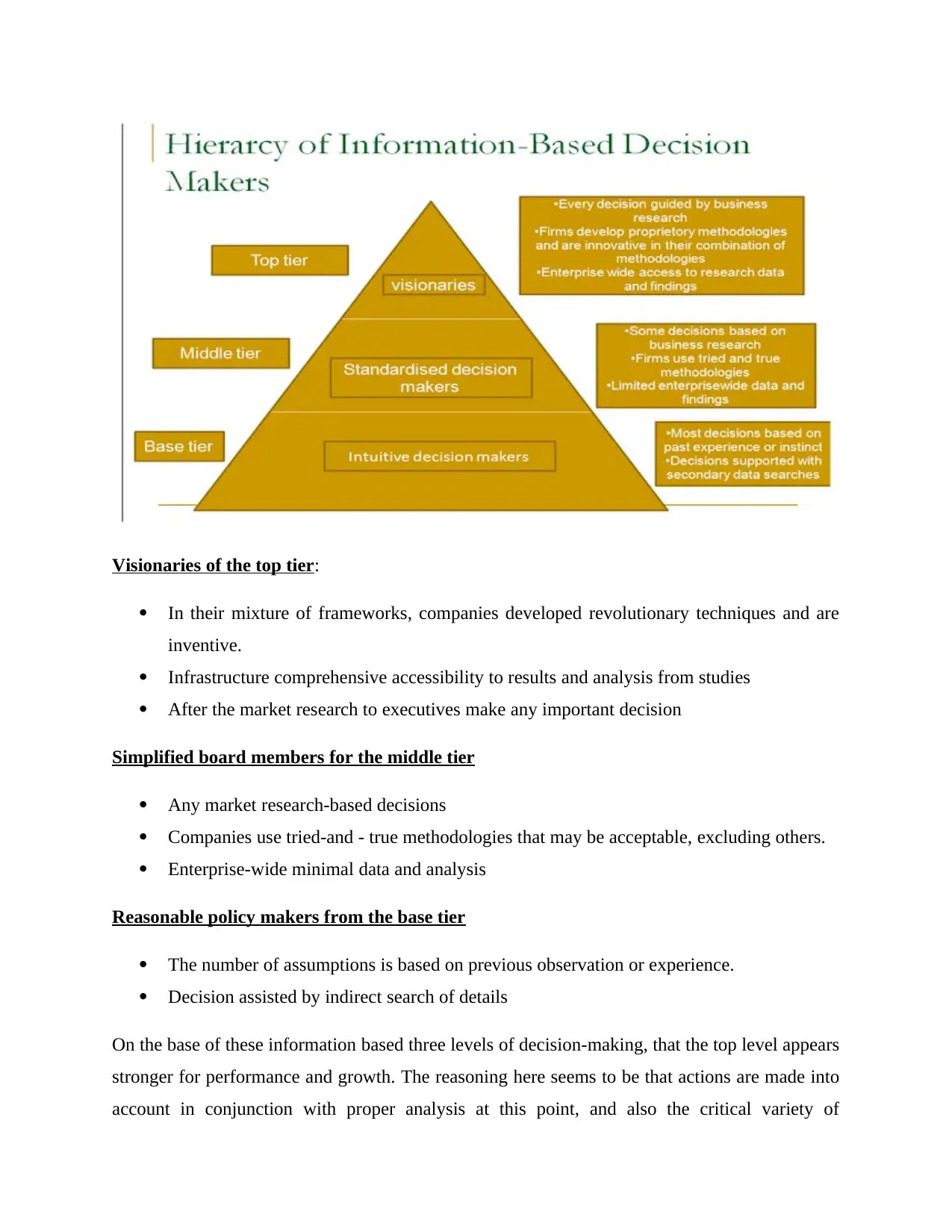
Visionaries of the top tier:
In their mixture of frameworks, companies developed revolutionary techniques and are
inventive.
Infrastructure comprehensive accessibility to results and analysis from studies
After the market research to executives make any important decision
Simplified board members for the middle tier
Any market research-based decisions
Companies use tried-and - true methodologies that may be acceptable, excluding others.
Enterprise-wide minimal data and analysis
Reasonable policy makers from the base tier
The number of assumptions is based on previous observation or experience.
Decision assisted by indirect search of details
On the base of these information based three levels of decision-making, that the top level appears
stronger for performance and growth. The reasoning here seems to be that actions are made into
account in conjunction with proper analysis at this point, and also the critical variety of
In their mixture of frameworks, companies developed revolutionary techniques and are
inventive.
Infrastructure comprehensive accessibility to results and analysis from studies
After the market research to executives make any important decision
Simplified board members for the middle tier
Any market research-based decisions
Companies use tried-and - true methodologies that may be acceptable, excluding others.
Enterprise-wide minimal data and analysis
Reasonable policy makers from the base tier
The number of assumptions is based on previous observation or experience.
Decision assisted by indirect search of details
On the base of these information based three levels of decision-making, that the top level appears
stronger for performance and growth. The reasoning here seems to be that actions are made into
account in conjunction with proper analysis at this point, and also the critical variety of
Paraphrase This Document
Need a fresh take? Get an instant paraphrase of this document with our AI Paraphraser
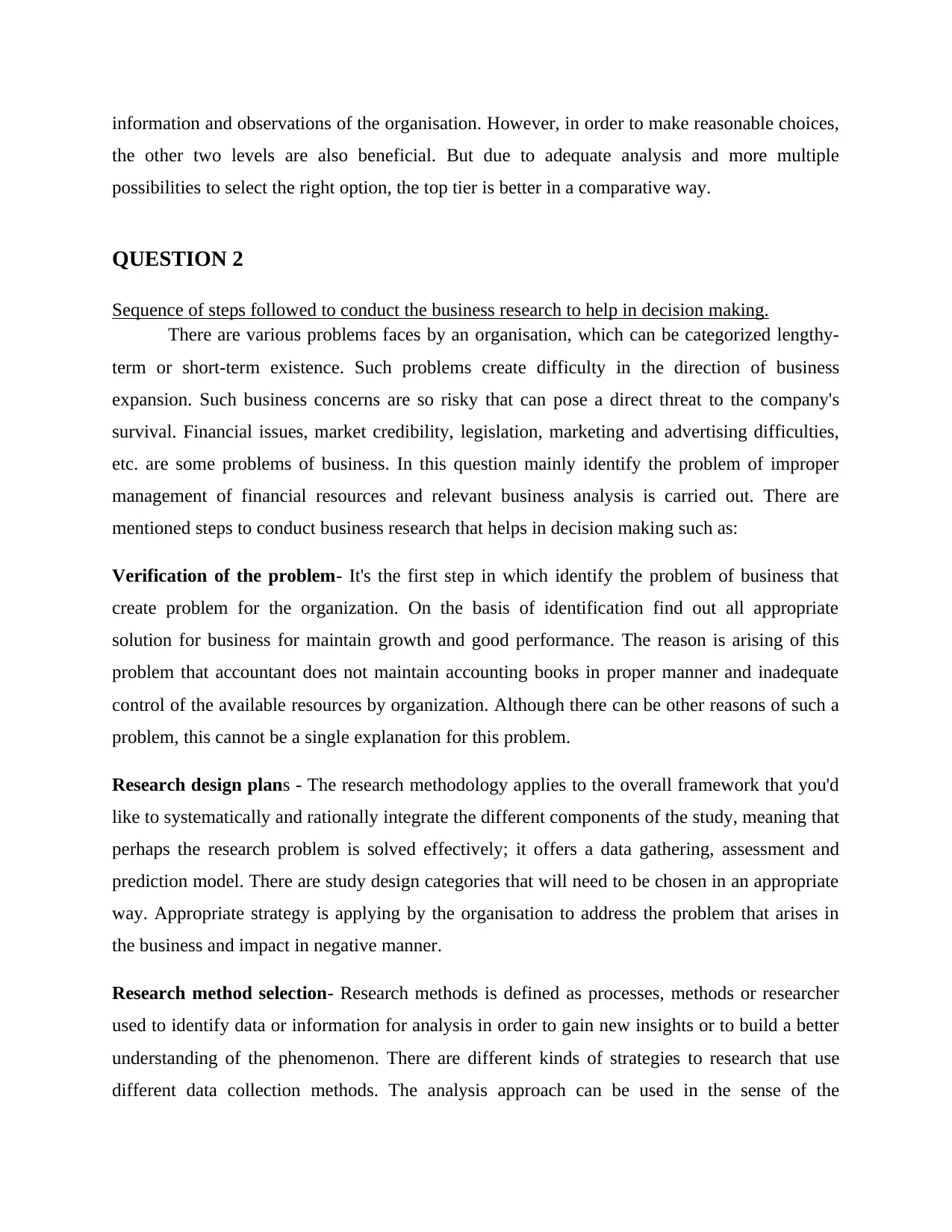
information and observations of the organisation. However, in order to make reasonable choices,
the other two levels are also beneficial. But due to adequate analysis and more multiple
possibilities to select the right option, the top tier is better in a comparative way.
QUESTION 2
Sequence of steps followed to conduct the business research to help in decision making.
There are various problems faces by an organisation, which can be categorized lengthy-
term or short-term existence. Such problems create difficulty in the direction of business
expansion. Such business concerns are so risky that can pose a direct threat to the company's
survival. Financial issues, market credibility, legislation, marketing and advertising difficulties,
etc. are some problems of business. In this question mainly identify the problem of improper
management of financial resources and relevant business analysis is carried out. There are
mentioned steps to conduct business research that helps in decision making such as:
Verification of the problem- It's the first step in which identify the problem of business that
create problem for the organization. On the basis of identification find out all appropriate
solution for business for maintain growth and good performance. The reason is arising of this
problem that accountant does not maintain accounting books in proper manner and inadequate
control of the available resources by organization. Although there can be other reasons of such a
problem, this cannot be a single explanation for this problem.
Research design plans - The research methodology applies to the overall framework that you'd
like to systematically and rationally integrate the different components of the study, meaning that
perhaps the research problem is solved effectively; it offers a data gathering, assessment and
prediction model. There are study design categories that will need to be chosen in an appropriate
way. Appropriate strategy is applying by the organisation to address the problem that arises in
the business and impact in negative manner.
Research method selection- Research methods is defined as processes, methods or researcher
used to identify data or information for analysis in order to gain new insights or to build a better
understanding of the phenomenon. There are different kinds of strategies to research that use
different data collection methods. The analysis approach can be used in the sense of the
the other two levels are also beneficial. But due to adequate analysis and more multiple
possibilities to select the right option, the top tier is better in a comparative way.
QUESTION 2
Sequence of steps followed to conduct the business research to help in decision making.
There are various problems faces by an organisation, which can be categorized lengthy-
term or short-term existence. Such problems create difficulty in the direction of business
expansion. Such business concerns are so risky that can pose a direct threat to the company's
survival. Financial issues, market credibility, legislation, marketing and advertising difficulties,
etc. are some problems of business. In this question mainly identify the problem of improper
management of financial resources and relevant business analysis is carried out. There are
mentioned steps to conduct business research that helps in decision making such as:
Verification of the problem- It's the first step in which identify the problem of business that
create problem for the organization. On the basis of identification find out all appropriate
solution for business for maintain growth and good performance. The reason is arising of this
problem that accountant does not maintain accounting books in proper manner and inadequate
control of the available resources by organization. Although there can be other reasons of such a
problem, this cannot be a single explanation for this problem.
Research design plans - The research methodology applies to the overall framework that you'd
like to systematically and rationally integrate the different components of the study, meaning that
perhaps the research problem is solved effectively; it offers a data gathering, assessment and
prediction model. There are study design categories that will need to be chosen in an appropriate
way. Appropriate strategy is applying by the organisation to address the problem that arises in
the business and impact in negative manner.
Research method selection- Research methods is defined as processes, methods or researcher
used to identify data or information for analysis in order to gain new insights or to build a better
understanding of the phenomenon. There are different kinds of strategies to research that use
different data collection methods. The analysis approach can be used in the sense of the
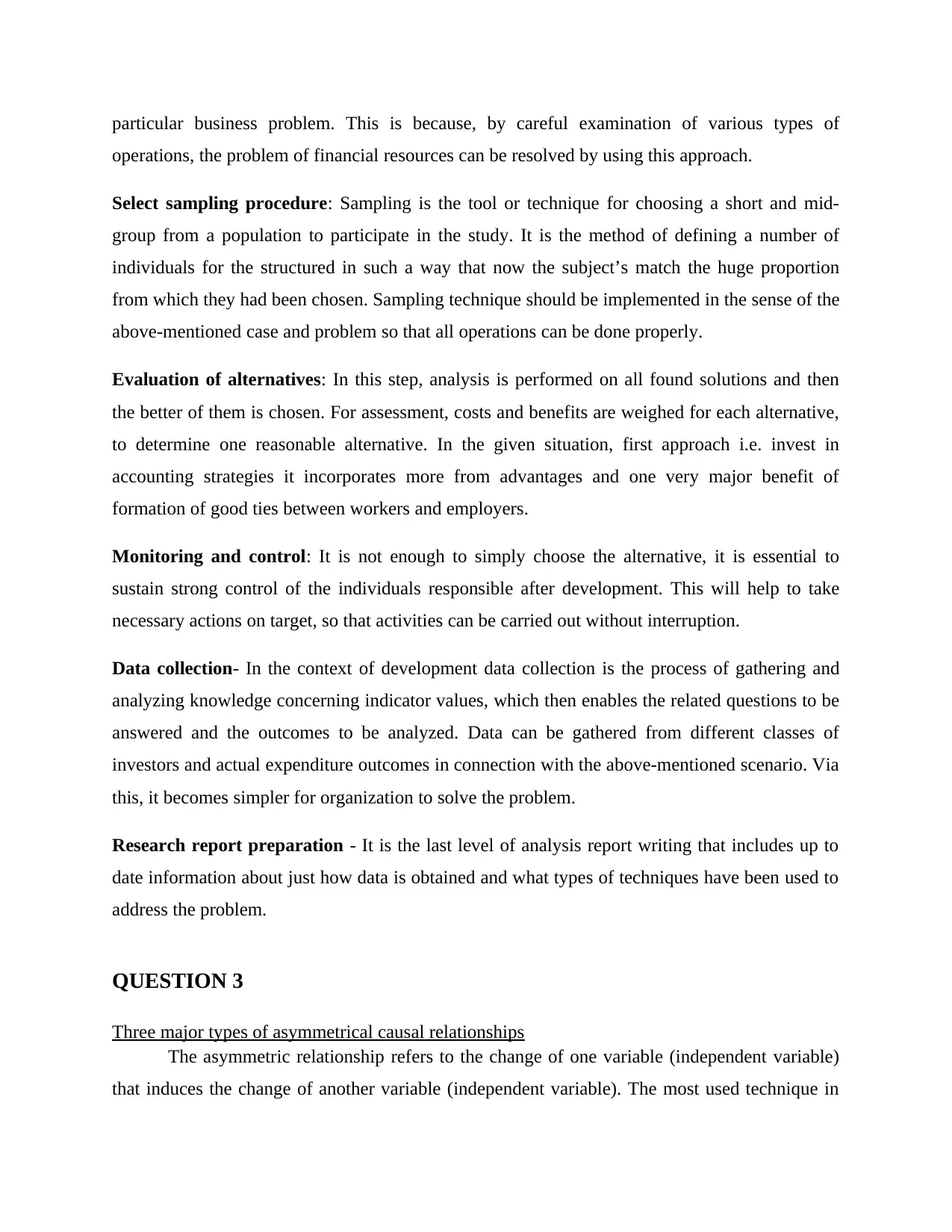
particular business problem. This is because, by careful examination of various types of
operations, the problem of financial resources can be resolved by using this approach.
Select sampling procedure: Sampling is the tool or technique for choosing a short and mid-
group from a population to participate in the study. It is the method of defining a number of
individuals for the structured in such a way that now the subject’s match the huge proportion
from which they had been chosen. Sampling technique should be implemented in the sense of the
above-mentioned case and problem so that all operations can be done properly.
Evaluation of alternatives: In this step, analysis is performed on all found solutions and then
the better of them is chosen. For assessment, costs and benefits are weighed for each alternative,
to determine one reasonable alternative. In the given situation, first approach i.e. invest in
accounting strategies it incorporates more from advantages and one very major benefit of
formation of good ties between workers and employers.
Monitoring and control: It is not enough to simply choose the alternative, it is essential to
sustain strong control of the individuals responsible after development. This will help to take
necessary actions on target, so that activities can be carried out without interruption.
Data collection- In the context of development data collection is the process of gathering and
analyzing knowledge concerning indicator values, which then enables the related questions to be
answered and the outcomes to be analyzed. Data can be gathered from different classes of
investors and actual expenditure outcomes in connection with the above-mentioned scenario. Via
this, it becomes simpler for organization to solve the problem.
Research report preparation - It is the last level of analysis report writing that includes up to
date information about just how data is obtained and what types of techniques have been used to
address the problem.
QUESTION 3
Three major types of asymmetrical causal relationships
The asymmetric relationship refers to the change of one variable (independent variable)
that induces the change of another variable (independent variable). The most used technique in
operations, the problem of financial resources can be resolved by using this approach.
Select sampling procedure: Sampling is the tool or technique for choosing a short and mid-
group from a population to participate in the study. It is the method of defining a number of
individuals for the structured in such a way that now the subject’s match the huge proportion
from which they had been chosen. Sampling technique should be implemented in the sense of the
above-mentioned case and problem so that all operations can be done properly.
Evaluation of alternatives: In this step, analysis is performed on all found solutions and then
the better of them is chosen. For assessment, costs and benefits are weighed for each alternative,
to determine one reasonable alternative. In the given situation, first approach i.e. invest in
accounting strategies it incorporates more from advantages and one very major benefit of
formation of good ties between workers and employers.
Monitoring and control: It is not enough to simply choose the alternative, it is essential to
sustain strong control of the individuals responsible after development. This will help to take
necessary actions on target, so that activities can be carried out without interruption.
Data collection- In the context of development data collection is the process of gathering and
analyzing knowledge concerning indicator values, which then enables the related questions to be
answered and the outcomes to be analyzed. Data can be gathered from different classes of
investors and actual expenditure outcomes in connection with the above-mentioned scenario. Via
this, it becomes simpler for organization to solve the problem.
Research report preparation - It is the last level of analysis report writing that includes up to
date information about just how data is obtained and what types of techniques have been used to
address the problem.
QUESTION 3
Three major types of asymmetrical causal relationships
The asymmetric relationship refers to the change of one variable (independent variable)
that induces the change of another variable (independent variable). The most used technique in
⊘ This is a preview!⊘
Do you want full access?
Subscribe today to unlock all pages.

Trusted by 1+ million students worldwide
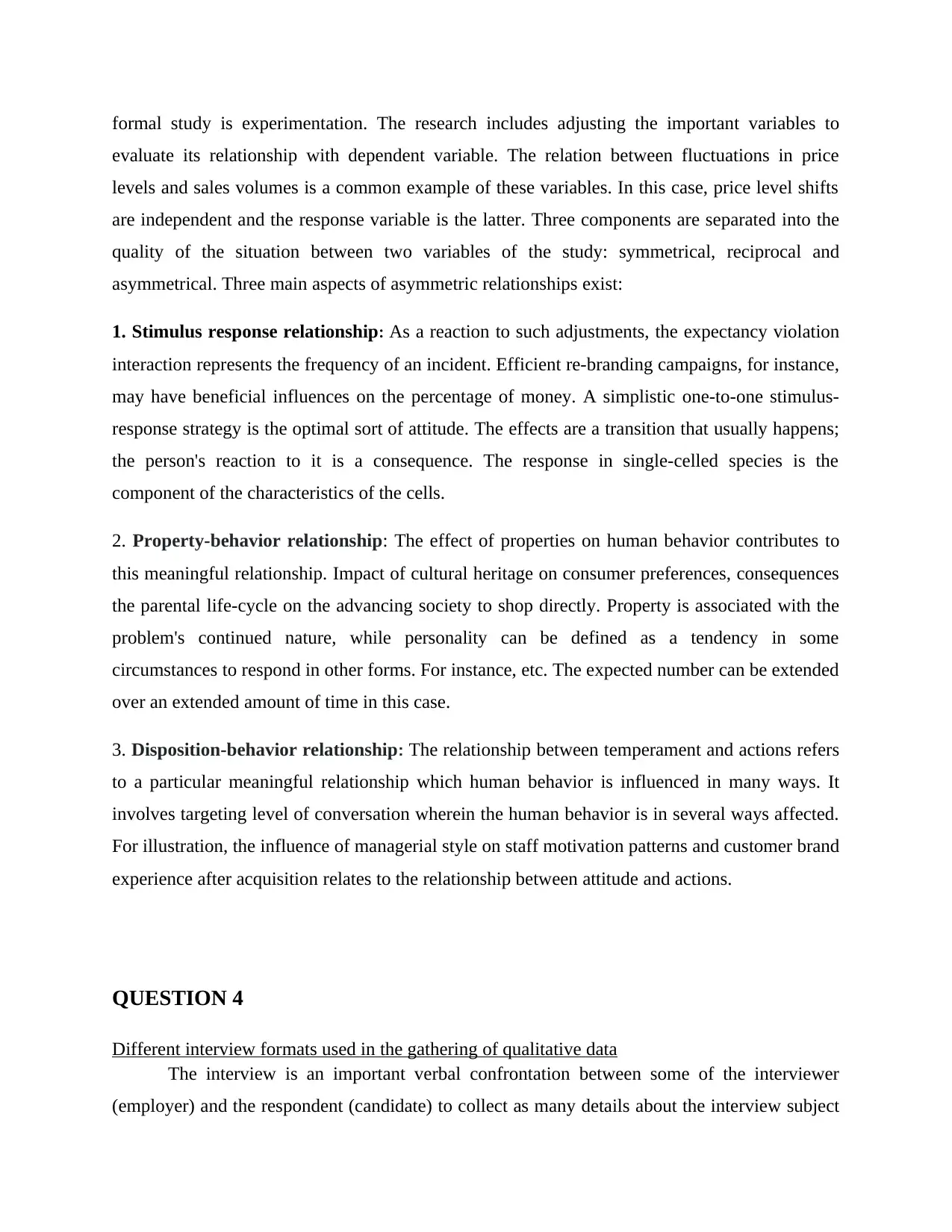
formal study is experimentation. The research includes adjusting the important variables to
evaluate its relationship with dependent variable. The relation between fluctuations in price
levels and sales volumes is a common example of these variables. In this case, price level shifts
are independent and the response variable is the latter. Three components are separated into the
quality of the situation between two variables of the study: symmetrical, reciprocal and
asymmetrical. Three main aspects of asymmetric relationships exist:
1. Stimulus response relationship: As a reaction to such adjustments, the expectancy violation
interaction represents the frequency of an incident. Efficient re-branding campaigns, for instance,
may have beneficial influences on the percentage of money. A simplistic one-to-one stimulus-
response strategy is the optimal sort of attitude. The effects are a transition that usually happens;
the person's reaction to it is a consequence. The response in single-celled species is the
component of the characteristics of the cells.
2. Property-behavior relationship: The effect of properties on human behavior contributes to
this meaningful relationship. Impact of cultural heritage on consumer preferences, consequences
the parental life-cycle on the advancing society to shop directly. Property is associated with the
problem's continued nature, while personality can be defined as a tendency in some
circumstances to respond in other forms. For instance, etc. The expected number can be extended
over an extended amount of time in this case.
3. Disposition-behavior relationship: The relationship between temperament and actions refers
to a particular meaningful relationship which human behavior is influenced in many ways. It
involves targeting level of conversation wherein the human behavior is in several ways affected.
For illustration, the influence of managerial style on staff motivation patterns and customer brand
experience after acquisition relates to the relationship between attitude and actions.
QUESTION 4
Different interview formats used in the gathering of qualitative data
The interview is an important verbal confrontation between some of the interviewer
(employer) and the respondent (candidate) to collect as many details about the interview subject
evaluate its relationship with dependent variable. The relation between fluctuations in price
levels and sales volumes is a common example of these variables. In this case, price level shifts
are independent and the response variable is the latter. Three components are separated into the
quality of the situation between two variables of the study: symmetrical, reciprocal and
asymmetrical. Three main aspects of asymmetric relationships exist:
1. Stimulus response relationship: As a reaction to such adjustments, the expectancy violation
interaction represents the frequency of an incident. Efficient re-branding campaigns, for instance,
may have beneficial influences on the percentage of money. A simplistic one-to-one stimulus-
response strategy is the optimal sort of attitude. The effects are a transition that usually happens;
the person's reaction to it is a consequence. The response in single-celled species is the
component of the characteristics of the cells.
2. Property-behavior relationship: The effect of properties on human behavior contributes to
this meaningful relationship. Impact of cultural heritage on consumer preferences, consequences
the parental life-cycle on the advancing society to shop directly. Property is associated with the
problem's continued nature, while personality can be defined as a tendency in some
circumstances to respond in other forms. For instance, etc. The expected number can be extended
over an extended amount of time in this case.
3. Disposition-behavior relationship: The relationship between temperament and actions refers
to a particular meaningful relationship which human behavior is influenced in many ways. It
involves targeting level of conversation wherein the human behavior is in several ways affected.
For illustration, the influence of managerial style on staff motivation patterns and customer brand
experience after acquisition relates to the relationship between attitude and actions.
QUESTION 4
Different interview formats used in the gathering of qualitative data
The interview is an important verbal confrontation between some of the interviewer
(employer) and the respondent (candidate) to collect as many details about the interview subject
Paraphrase This Document
Need a fresh take? Get an instant paraphrase of this document with our AI Paraphraser
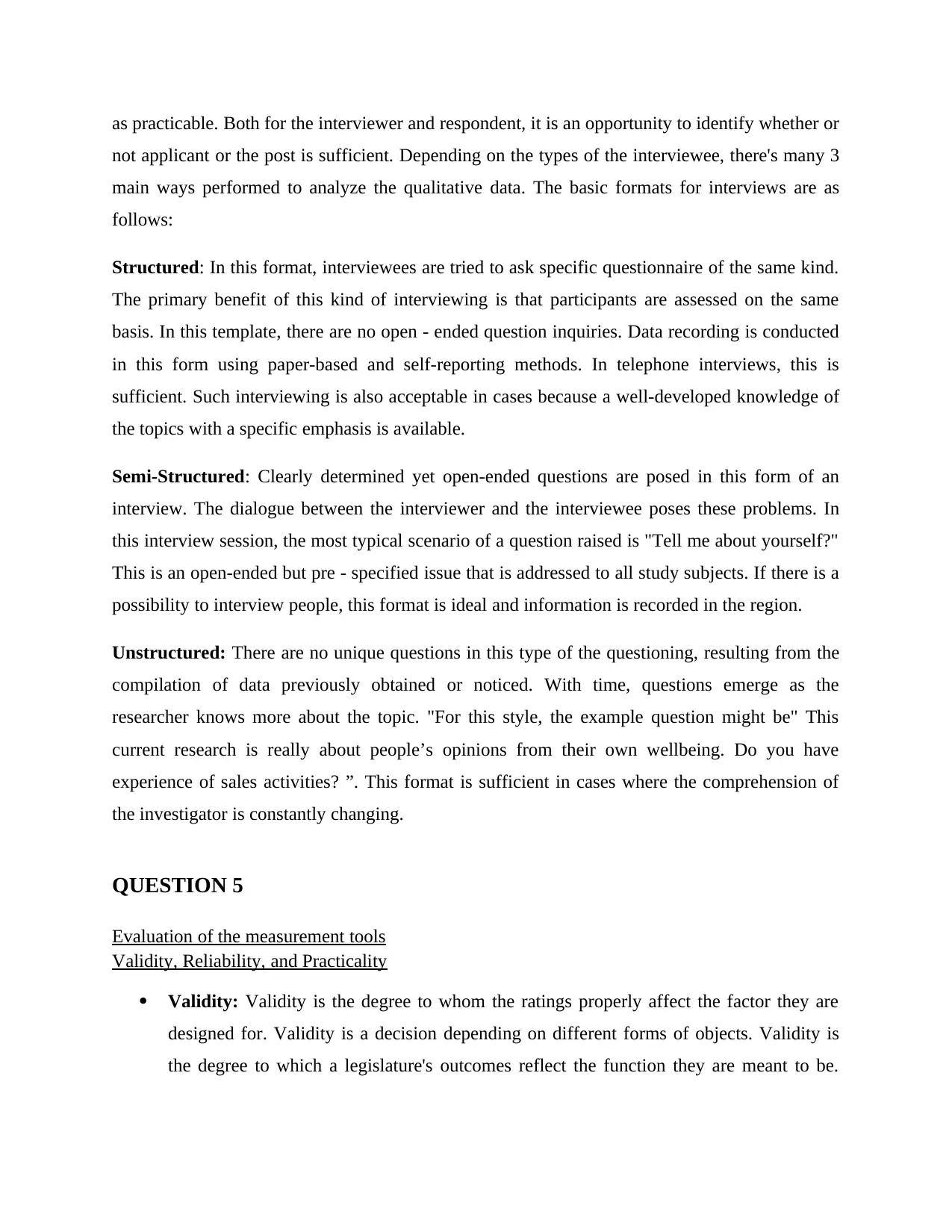
as practicable. Both for the interviewer and respondent, it is an opportunity to identify whether or
not applicant or the post is sufficient. Depending on the types of the interviewee, there's many 3
main ways performed to analyze the qualitative data. The basic formats for interviews are as
follows:
Structured: In this format, interviewees are tried to ask specific questionnaire of the same kind.
The primary benefit of this kind of interviewing is that participants are assessed on the same
basis. In this template, there are no open - ended question inquiries. Data recording is conducted
in this form using paper-based and self-reporting methods. In telephone interviews, this is
sufficient. Such interviewing is also acceptable in cases because a well-developed knowledge of
the topics with a specific emphasis is available.
Semi-Structured: Clearly determined yet open-ended questions are posed in this form of an
interview. The dialogue between the interviewer and the interviewee poses these problems. In
this interview session, the most typical scenario of a question raised is "Tell me about yourself?"
This is an open-ended but pre - specified issue that is addressed to all study subjects. If there is a
possibility to interview people, this format is ideal and information is recorded in the region.
Unstructured: There are no unique questions in this type of the questioning, resulting from the
compilation of data previously obtained or noticed. With time, questions emerge as the
researcher knows more about the topic. "For this style, the example question might be" This
current research is really about people’s opinions from their own wellbeing. Do you have
experience of sales activities? ”. This format is sufficient in cases where the comprehension of
the investigator is constantly changing.
QUESTION 5
Evaluation of the measurement tools
Validity, Reliability, and Practicality
Validity: Validity is the degree to whom the ratings properly affect the factor they are
designed for. Validity is a decision depending on different forms of objects. Validity is
the degree to which a legislature's outcomes reflect the function they are meant to be.
not applicant or the post is sufficient. Depending on the types of the interviewee, there's many 3
main ways performed to analyze the qualitative data. The basic formats for interviews are as
follows:
Structured: In this format, interviewees are tried to ask specific questionnaire of the same kind.
The primary benefit of this kind of interviewing is that participants are assessed on the same
basis. In this template, there are no open - ended question inquiries. Data recording is conducted
in this form using paper-based and self-reporting methods. In telephone interviews, this is
sufficient. Such interviewing is also acceptable in cases because a well-developed knowledge of
the topics with a specific emphasis is available.
Semi-Structured: Clearly determined yet open-ended questions are posed in this form of an
interview. The dialogue between the interviewer and the interviewee poses these problems. In
this interview session, the most typical scenario of a question raised is "Tell me about yourself?"
This is an open-ended but pre - specified issue that is addressed to all study subjects. If there is a
possibility to interview people, this format is ideal and information is recorded in the region.
Unstructured: There are no unique questions in this type of the questioning, resulting from the
compilation of data previously obtained or noticed. With time, questions emerge as the
researcher knows more about the topic. "For this style, the example question might be" This
current research is really about people’s opinions from their own wellbeing. Do you have
experience of sales activities? ”. This format is sufficient in cases where the comprehension of
the investigator is constantly changing.
QUESTION 5
Evaluation of the measurement tools
Validity, Reliability, and Practicality
Validity: Validity is the degree to whom the ratings properly affect the factor they are
designed for. Validity is a decision depending on different forms of objects. Validity is
the degree to which a legislature's outcomes reflect the function they are meant to be.
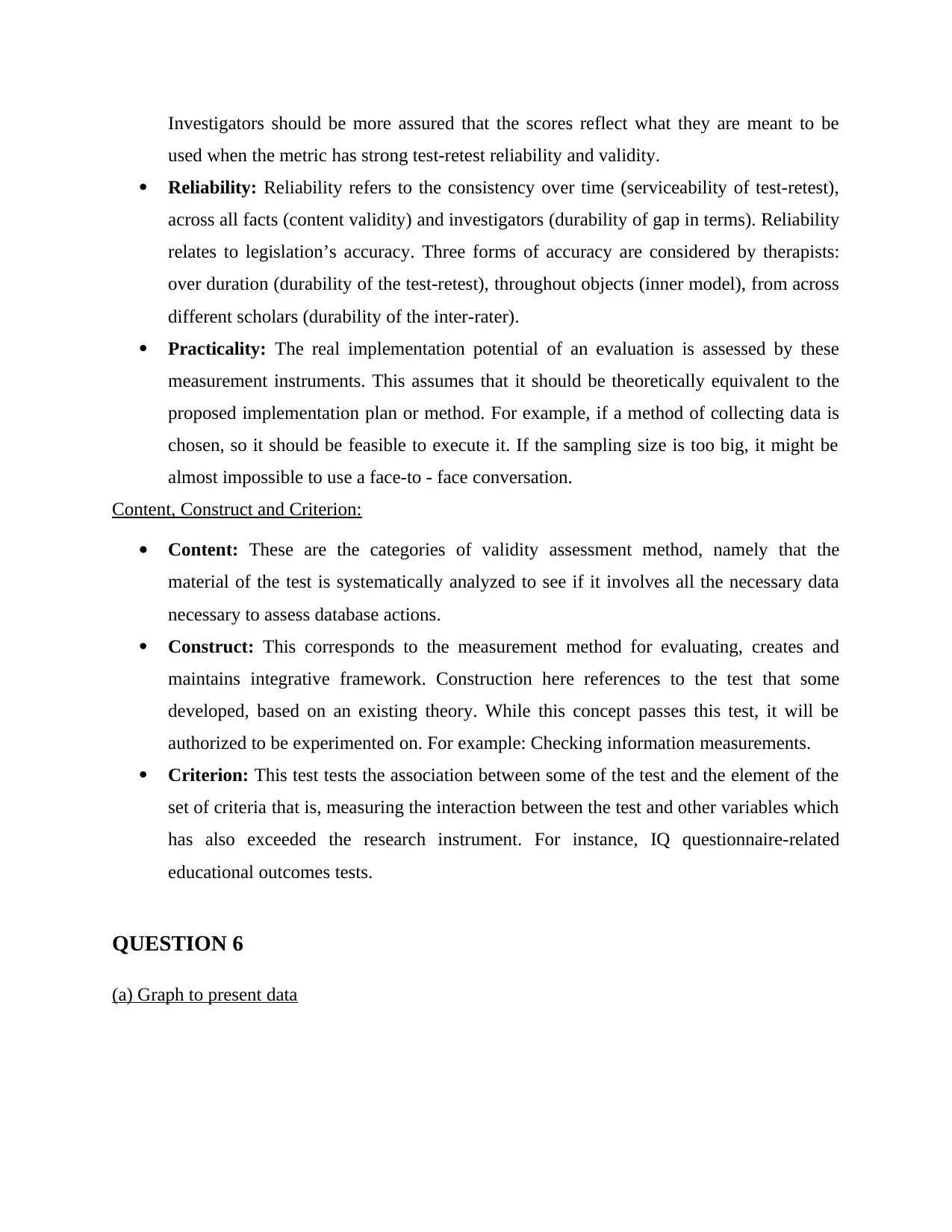
Investigators should be more assured that the scores reflect what they are meant to be
used when the metric has strong test-retest reliability and validity.
Reliability: Reliability refers to the consistency over time (serviceability of test-retest),
across all facts (content validity) and investigators (durability of gap in terms). Reliability
relates to legislation’s accuracy. Three forms of accuracy are considered by therapists:
over duration (durability of the test-retest), throughout objects (inner model), from across
different scholars (durability of the inter-rater).
Practicality: The real implementation potential of an evaluation is assessed by these
measurement instruments. This assumes that it should be theoretically equivalent to the
proposed implementation plan or method. For example, if a method of collecting data is
chosen, so it should be feasible to execute it. If the sampling size is too big, it might be
almost impossible to use a face-to - face conversation.
Content, Construct and Criterion:
Content: These are the categories of validity assessment method, namely that the
material of the test is systematically analyzed to see if it involves all the necessary data
necessary to assess database actions.
Construct: This corresponds to the measurement method for evaluating, creates and
maintains integrative framework. Construction here references to the test that some
developed, based on an existing theory. While this concept passes this test, it will be
authorized to be experimented on. For example: Checking information measurements.
Criterion: This test tests the association between some of the test and the element of the
set of criteria that is, measuring the interaction between the test and other variables which
has also exceeded the research instrument. For instance, IQ questionnaire-related
educational outcomes tests.
QUESTION 6
(a) Graph to present data
used when the metric has strong test-retest reliability and validity.
Reliability: Reliability refers to the consistency over time (serviceability of test-retest),
across all facts (content validity) and investigators (durability of gap in terms). Reliability
relates to legislation’s accuracy. Three forms of accuracy are considered by therapists:
over duration (durability of the test-retest), throughout objects (inner model), from across
different scholars (durability of the inter-rater).
Practicality: The real implementation potential of an evaluation is assessed by these
measurement instruments. This assumes that it should be theoretically equivalent to the
proposed implementation plan or method. For example, if a method of collecting data is
chosen, so it should be feasible to execute it. If the sampling size is too big, it might be
almost impossible to use a face-to - face conversation.
Content, Construct and Criterion:
Content: These are the categories of validity assessment method, namely that the
material of the test is systematically analyzed to see if it involves all the necessary data
necessary to assess database actions.
Construct: This corresponds to the measurement method for evaluating, creates and
maintains integrative framework. Construction here references to the test that some
developed, based on an existing theory. While this concept passes this test, it will be
authorized to be experimented on. For example: Checking information measurements.
Criterion: This test tests the association between some of the test and the element of the
set of criteria that is, measuring the interaction between the test and other variables which
has also exceeded the research instrument. For instance, IQ questionnaire-related
educational outcomes tests.
QUESTION 6
(a) Graph to present data
⊘ This is a preview!⊘
Do you want full access?
Subscribe today to unlock all pages.

Trusted by 1+ million students worldwide
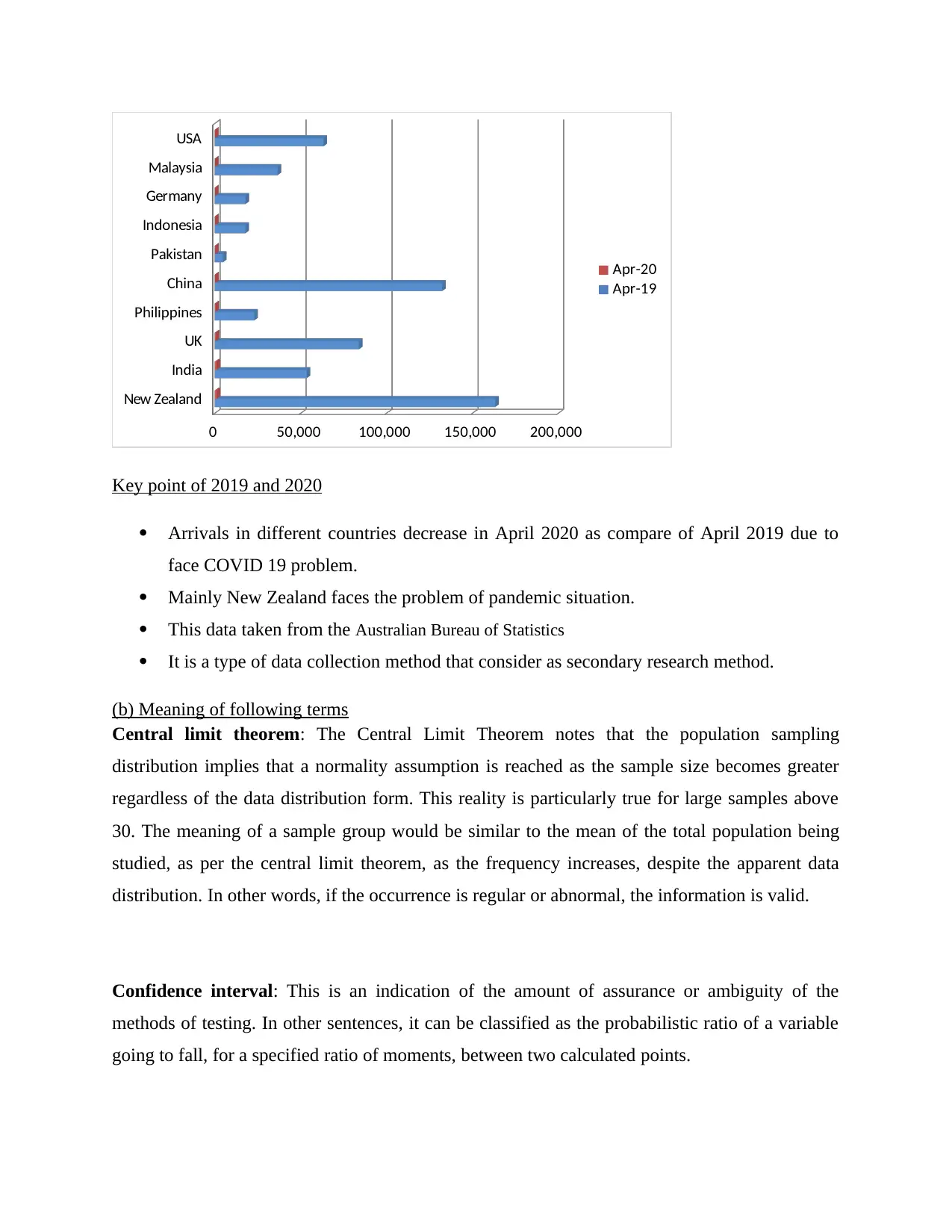
New Zealand
India
UK
Philippines
China
Pakistan
Indonesia
Germany
Malaysia
USA
0 50,000 100,000 150,000 200,000
Apr-20
Apr-19
Key point of 2019 and 2020
Arrivals in different countries decrease in April 2020 as compare of April 2019 due to
face COVID 19 problem.
Mainly New Zealand faces the problem of pandemic situation.
This data taken from the Australian Bureau of Statistics
It is a type of data collection method that consider as secondary research method.
(b) Meaning of following terms
Central limit theorem: The Central Limit Theorem notes that the population sampling
distribution implies that a normality assumption is reached as the sample size becomes greater
regardless of the data distribution form. This reality is particularly true for large samples above
30. The meaning of a sample group would be similar to the mean of the total population being
studied, as per the central limit theorem, as the frequency increases, despite the apparent data
distribution. In other words, if the occurrence is regular or abnormal, the information is valid.
Confidence interval: This is an indication of the amount of assurance or ambiguity of the
methods of testing. In other sentences, it can be classified as the probabilistic ratio of a variable
going to fall, for a specified ratio of moments, between two calculated points.
India
UK
Philippines
China
Pakistan
Indonesia
Germany
Malaysia
USA
0 50,000 100,000 150,000 200,000
Apr-20
Apr-19
Key point of 2019 and 2020
Arrivals in different countries decrease in April 2020 as compare of April 2019 due to
face COVID 19 problem.
Mainly New Zealand faces the problem of pandemic situation.
This data taken from the Australian Bureau of Statistics
It is a type of data collection method that consider as secondary research method.
(b) Meaning of following terms
Central limit theorem: The Central Limit Theorem notes that the population sampling
distribution implies that a normality assumption is reached as the sample size becomes greater
regardless of the data distribution form. This reality is particularly true for large samples above
30. The meaning of a sample group would be similar to the mean of the total population being
studied, as per the central limit theorem, as the frequency increases, despite the apparent data
distribution. In other words, if the occurrence is regular or abnormal, the information is valid.
Confidence interval: This is an indication of the amount of assurance or ambiguity of the
methods of testing. In other sentences, it can be classified as the probabilistic ratio of a variable
going to fall, for a specified ratio of moments, between two calculated points.
Paraphrase This Document
Need a fresh take? Get an instant paraphrase of this document with our AI Paraphraser
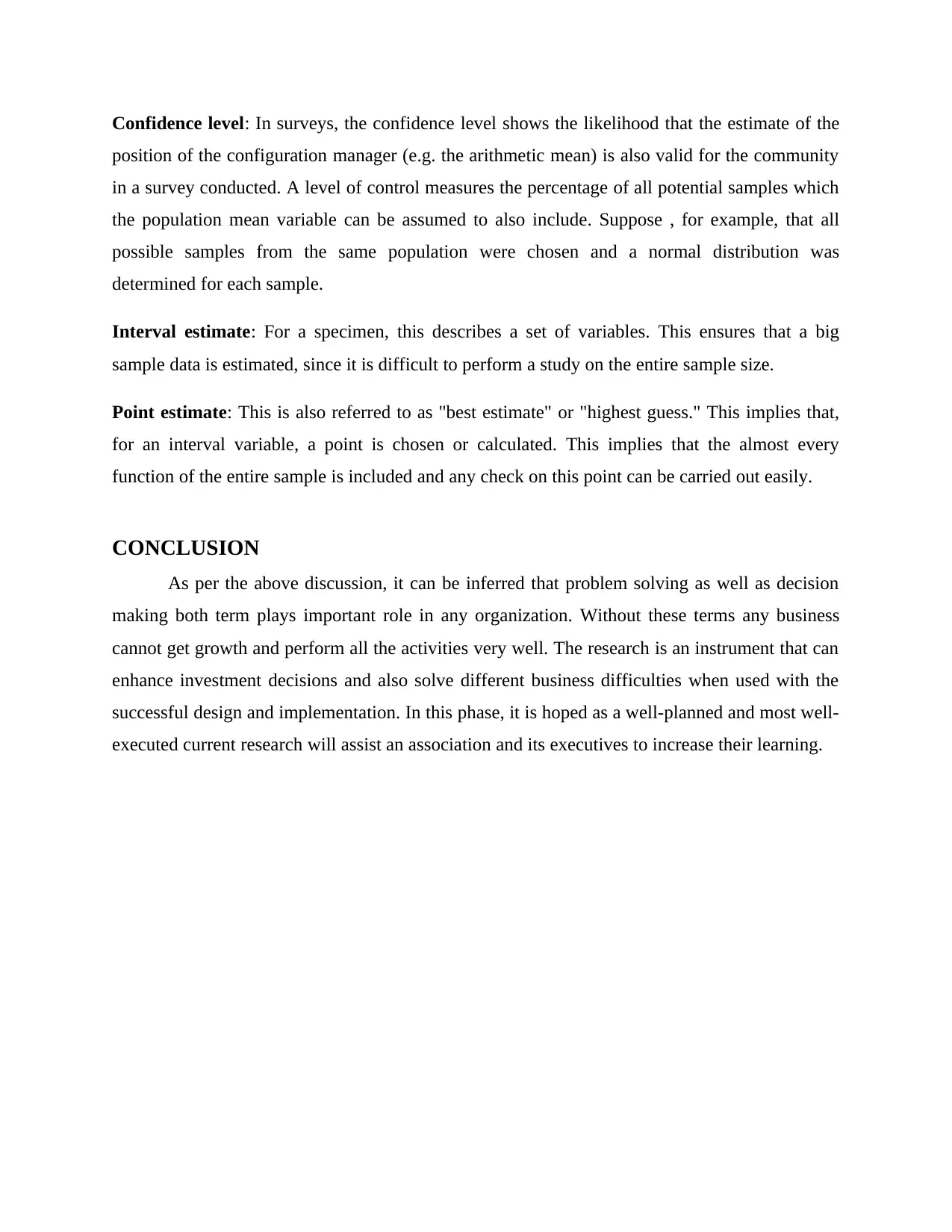
Confidence level: In surveys, the confidence level shows the likelihood that the estimate of the
position of the configuration manager (e.g. the arithmetic mean) is also valid for the community
in a survey conducted. A level of control measures the percentage of all potential samples which
the population mean variable can be assumed to also include. Suppose , for example, that all
possible samples from the same population were chosen and a normal distribution was
determined for each sample.
Interval estimate: For a specimen, this describes a set of variables. This ensures that a big
sample data is estimated, since it is difficult to perform a study on the entire sample size.
Point estimate: This is also referred to as "best estimate" or "highest guess." This implies that,
for an interval variable, a point is chosen or calculated. This implies that the almost every
function of the entire sample is included and any check on this point can be carried out easily.
CONCLUSION
As per the above discussion, it can be inferred that problem solving as well as decision
making both term plays important role in any organization. Without these terms any business
cannot get growth and perform all the activities very well. The research is an instrument that can
enhance investment decisions and also solve different business difficulties when used with the
successful design and implementation. In this phase, it is hoped as a well-planned and most well-
executed current research will assist an association and its executives to increase their learning.
position of the configuration manager (e.g. the arithmetic mean) is also valid for the community
in a survey conducted. A level of control measures the percentage of all potential samples which
the population mean variable can be assumed to also include. Suppose , for example, that all
possible samples from the same population were chosen and a normal distribution was
determined for each sample.
Interval estimate: For a specimen, this describes a set of variables. This ensures that a big
sample data is estimated, since it is difficult to perform a study on the entire sample size.
Point estimate: This is also referred to as "best estimate" or "highest guess." This implies that,
for an interval variable, a point is chosen or calculated. This implies that the almost every
function of the entire sample is included and any check on this point can be carried out easily.
CONCLUSION
As per the above discussion, it can be inferred that problem solving as well as decision
making both term plays important role in any organization. Without these terms any business
cannot get growth and perform all the activities very well. The research is an instrument that can
enhance investment decisions and also solve different business difficulties when used with the
successful design and implementation. In this phase, it is hoped as a well-planned and most well-
executed current research will assist an association and its executives to increase their learning.
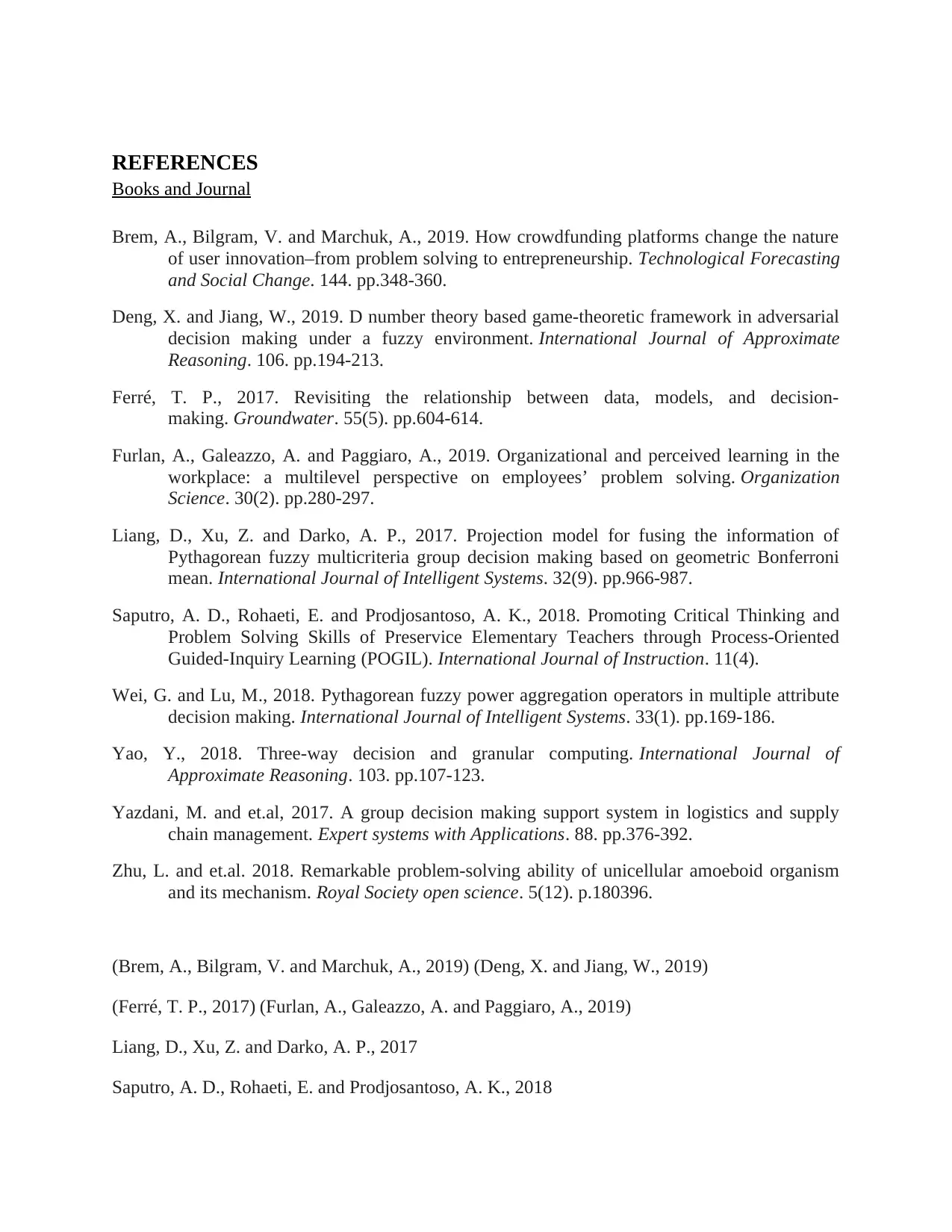
REFERENCES
Books and Journal
Brem, A., Bilgram, V. and Marchuk, A., 2019. How crowdfunding platforms change the nature
of user innovation–from problem solving to entrepreneurship. Technological Forecasting
and Social Change. 144. pp.348-360.
Deng, X. and Jiang, W., 2019. D number theory based game-theoretic framework in adversarial
decision making under a fuzzy environment. International Journal of Approximate
Reasoning. 106. pp.194-213.
Ferré, T. P., 2017. Revisiting the relationship between data, models, and decision‐
making. Groundwater. 55(5). pp.604-614.
Furlan, A., Galeazzo, A. and Paggiaro, A., 2019. Organizational and perceived learning in the
workplace: a multilevel perspective on employees’ problem solving. Organization
Science. 30(2). pp.280-297.
Liang, D., Xu, Z. and Darko, A. P., 2017. Projection model for fusing the information of
Pythagorean fuzzy multicriteria group decision making based on geometric Bonferroni
mean. International Journal of Intelligent Systems. 32(9). pp.966-987.
Saputro, A. D., Rohaeti, E. and Prodjosantoso, A. K., 2018. Promoting Critical Thinking and
Problem Solving Skills of Preservice Elementary Teachers through Process-Oriented
Guided-Inquiry Learning (POGIL). International Journal of Instruction. 11(4).
Wei, G. and Lu, M., 2018. Pythagorean fuzzy power aggregation operators in multiple attribute
decision making. International Journal of Intelligent Systems. 33(1). pp.169-186.
Yao, Y., 2018. Three-way decision and granular computing. International Journal of
Approximate Reasoning. 103. pp.107-123.
Yazdani, M. and et.al, 2017. A group decision making support system in logistics and supply
chain management. Expert systems with Applications. 88. pp.376-392.
Zhu, L. and et.al. 2018. Remarkable problem-solving ability of unicellular amoeboid organism
and its mechanism. Royal Society open science. 5(12). p.180396.
(Brem, A., Bilgram, V. and Marchuk, A., 2019) (Deng, X. and Jiang, W., 2019)
(Ferré, T. P., 2017) (Furlan, A., Galeazzo, A. and Paggiaro, A., 2019)
Liang, D., Xu, Z. and Darko, A. P., 2017
Saputro, A. D., Rohaeti, E. and Prodjosantoso, A. K., 2018
Books and Journal
Brem, A., Bilgram, V. and Marchuk, A., 2019. How crowdfunding platforms change the nature
of user innovation–from problem solving to entrepreneurship. Technological Forecasting
and Social Change. 144. pp.348-360.
Deng, X. and Jiang, W., 2019. D number theory based game-theoretic framework in adversarial
decision making under a fuzzy environment. International Journal of Approximate
Reasoning. 106. pp.194-213.
Ferré, T. P., 2017. Revisiting the relationship between data, models, and decision‐
making. Groundwater. 55(5). pp.604-614.
Furlan, A., Galeazzo, A. and Paggiaro, A., 2019. Organizational and perceived learning in the
workplace: a multilevel perspective on employees’ problem solving. Organization
Science. 30(2). pp.280-297.
Liang, D., Xu, Z. and Darko, A. P., 2017. Projection model for fusing the information of
Pythagorean fuzzy multicriteria group decision making based on geometric Bonferroni
mean. International Journal of Intelligent Systems. 32(9). pp.966-987.
Saputro, A. D., Rohaeti, E. and Prodjosantoso, A. K., 2018. Promoting Critical Thinking and
Problem Solving Skills of Preservice Elementary Teachers through Process-Oriented
Guided-Inquiry Learning (POGIL). International Journal of Instruction. 11(4).
Wei, G. and Lu, M., 2018. Pythagorean fuzzy power aggregation operators in multiple attribute
decision making. International Journal of Intelligent Systems. 33(1). pp.169-186.
Yao, Y., 2018. Three-way decision and granular computing. International Journal of
Approximate Reasoning. 103. pp.107-123.
Yazdani, M. and et.al, 2017. A group decision making support system in logistics and supply
chain management. Expert systems with Applications. 88. pp.376-392.
Zhu, L. and et.al. 2018. Remarkable problem-solving ability of unicellular amoeboid organism
and its mechanism. Royal Society open science. 5(12). p.180396.
(Brem, A., Bilgram, V. and Marchuk, A., 2019) (Deng, X. and Jiang, W., 2019)
(Ferré, T. P., 2017) (Furlan, A., Galeazzo, A. and Paggiaro, A., 2019)
Liang, D., Xu, Z. and Darko, A. P., 2017
Saputro, A. D., Rohaeti, E. and Prodjosantoso, A. K., 2018
⊘ This is a preview!⊘
Do you want full access?
Subscribe today to unlock all pages.

Trusted by 1+ million students worldwide
1 out of 13
Related Documents
Your All-in-One AI-Powered Toolkit for Academic Success.
+13062052269
info@desklib.com
Available 24*7 on WhatsApp / Email
![[object Object]](/_next/static/media/star-bottom.7253800d.svg)
Unlock your academic potential
Copyright © 2020–2025 A2Z Services. All Rights Reserved. Developed and managed by ZUCOL.





